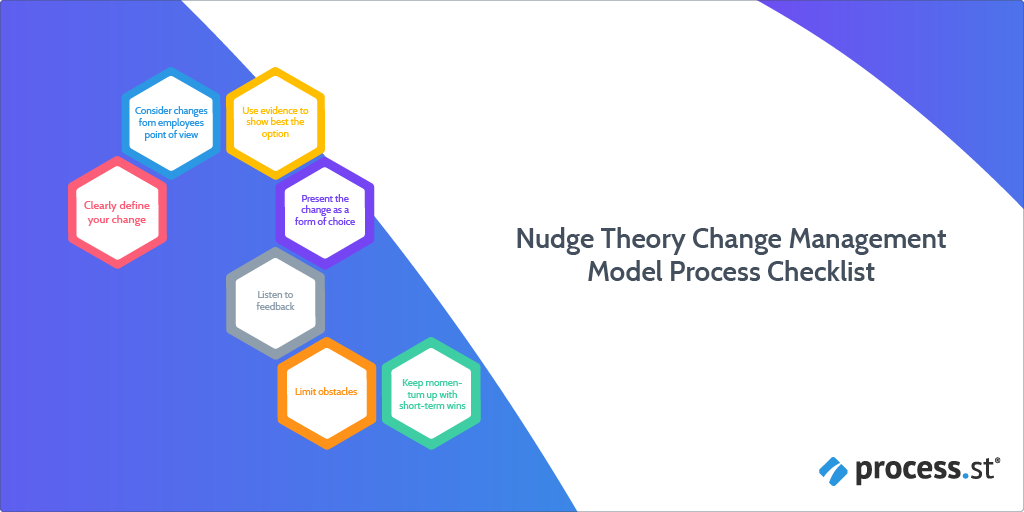Nudge Theory Change Management Model Process Checklist frames change more attractively. It is more of a theory that a change management model.
Nudge Theory Change Management Model: An introduction
The Nudge theory is a behavioral science concept developed by Richard Thaler and Cass Sunstein in the 2008 book Nudge: Improving Decisions About Health, Wealth, and Happiness.
The basis of the theory is that nudging change along is much more effective than trying to enforce it in a traditional sense. Rather than telling your employees what to do, the choice landscape is designed so that employees are choosing the needed change themselves.
This changing the choice landscape is known as nudging. The trick with Nudge Theory is knowing how to present these nudges.
The core aspects of nudges are ascertained as being:
- Indirect
- Subtle
- Open-ended
- Educational
- Backed up with evidence
- Optional
- Open to discussion
There is no set method to Nudge theory so in that sense the theory is vague. It is better to think of nudge theory as a tool to use with another, more structured change management model.
This checklist will follow the basic principles of nudge theory, so your team are nudged to choose your proposed changes:
- Clearly define your changes
- Consider changes from your employees point of view
- Use evidence to show the best options
- Present the change as a choice
- Listen to feedback
- Limit obstacles
- Keep the momentum up with short-term wins
What's good about it
Nudge theory helps the employee realize the importance of the issue and lets them choose the solution. This gives the employee choice, strengthening employee bonds with yourself and the business, leading to greater loyalty and lower employee turnover.
Nudge theory can be a great supplement to change management models that neglect the employee side to change. The theory looks at change from an employee perspective.
What's bad about it
As already mentioned, the nudge theory doesn't provide a model for analyzing, managing, deploying, and maintaining change and so it is best used as a supplement to another change management model. Because of this, implementing the nudge theory alongside another change management model is time and energy-consuming.
Nudge theory also suffers in terms of its predictability. Changing the landscape in favor of the employee to make a choice does not guarantee that the choice you want to be made is made.
How to use this checklist
At the beginning of this checklist, you will be presented with a set of specialized questions given as form fields. You are required to populate each form field with your data.
The checklist is broken down into the 7 stages of the Nudge Theory Change Management Model:
- Stage 1 - Clearly define your changes
- Stage 2 - Consider the changes from your employee point of view
- Stage 3 - Use evidence to show the best options
- Stage 4 - Present the changes as a choice
- Stage 5 - Listen to feedback
- Stage 6 - Limit obstacles
- Stage 7 - Keep the momentum up with short-term wins
At the end of each stage, your supervisor/manager will review your work using Process Street's approvals feature. Other features used in this template include:
- Stop tasks - To ensure task order.
- Dynamic due dates - To make sure your initiative is reviewed on time.
- Role assignment - To delegate tasks within your team ensuring your supervisors is appropriately assigned to the review tasks.
- Approvals - Tasks can be accepted, rejected, and rejected with comments.








